Scanning Around With Gene: Linoleum Love

A recent challenge to help a friend choose retro floor covering for a 1950s kitchen sent me to my magazine archives, particularly old issues of Better Homes and Gardens and Good Housekeeping. What I discovered was a treasure trove of great ads and great floor patterns. Styles have certainly changed over the years, but I must say I’d take a number of these looks as is.
A host of companies are bringing back “classic” linoleum, though much of it is made of new materials. True linoleum is made from more-or-less organic materials and in addition to its retro look, it turns out to be much greener than many flooring alternatives. So it’s enjoying a bit of a resurgence at the moment.
Click on any picture for a larger version. Here are two examples from 1937.


Linoleum also holds another interesting distinction: It’s the first example of a trademark that was ruled to be a generic term by the courts. That ruling was made in the 1870s, approximately 14 years after its invention. The images below are from 1939 and 1940.
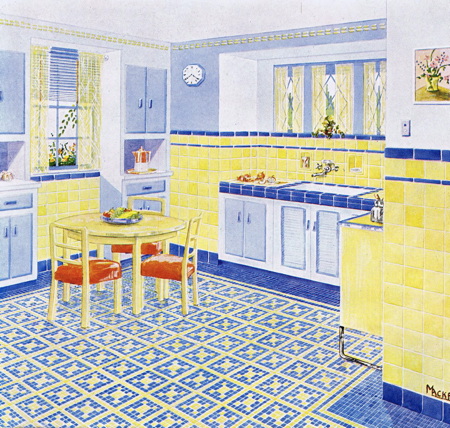

It was Englishman Frederick Walton who first patented the process of using linseed oil combined with various fillers to produce a hard floor covering. The term “linoleum” comes from the Latin linum (“flax”) and oleum (“oil”). Here’s linoleum in action circa 1947 and 1952.
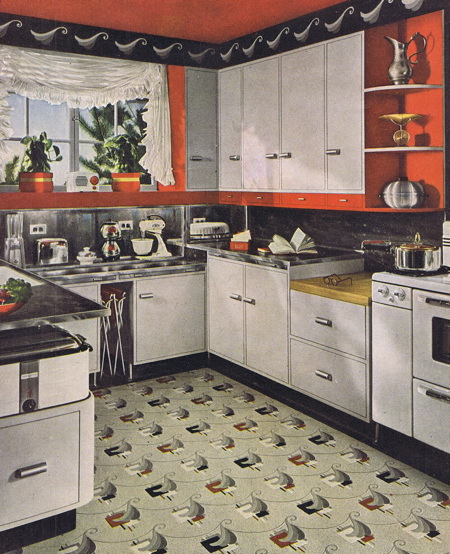

Quite a few firms began manufacturing linoleum and many came up with interesting ways to add colors and patterns. Some of them involved adding color crystals, which were then smashed through rollers, leading to the popular “confetti” look I came to know and love as a kid.
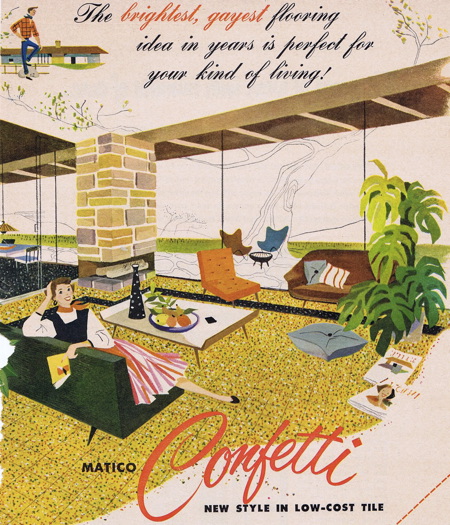

Other processes involved stencils, which produced more predictable patterns, and even inlay processes, which could make for very hard lines and distinct geometric shapes. Here are two beauties from 1934 and 1937.

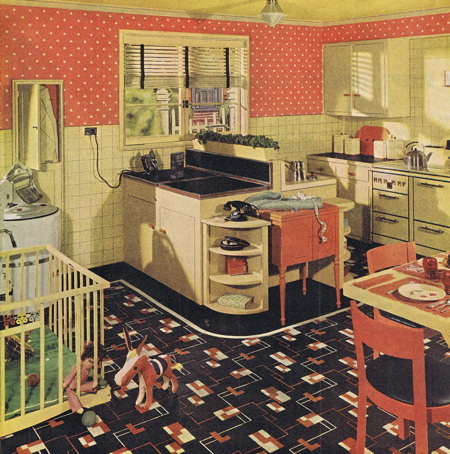
Some very early linoleum was painted with a pattern only on the surface, but one of the hallmarks of true linoleum is that the color goes all the way through, which makes for better wear and tear. Modern plastic or vinyl floor covering has the pattern screened on, and though durable, you can see worn spots much easier. From 1955 and 1941.
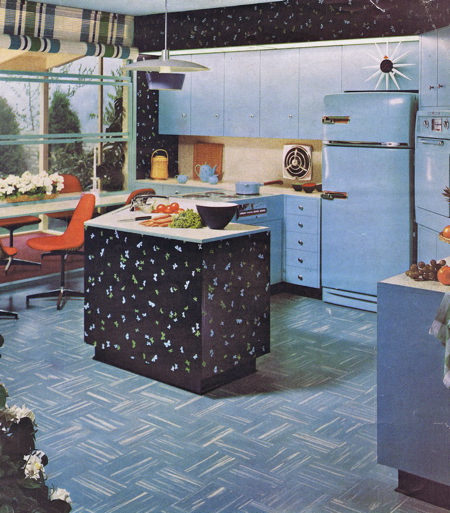

We seem to have gotten away from making a floor the centerpiece of a room, thanks to bolder paint colors and the desire to be able to change a room’s look more easily. But as you can see from many of these ads, the floor made the room back in the heyday of linoleum products. Here are three from 1937, 1934, and 1947.



Linoleum wasn’t limited to the kitchen or bath. It was great for playrooms, dens, and even bedrooms, as these pictures from 1960, 1954 and 1952 demonstrate.

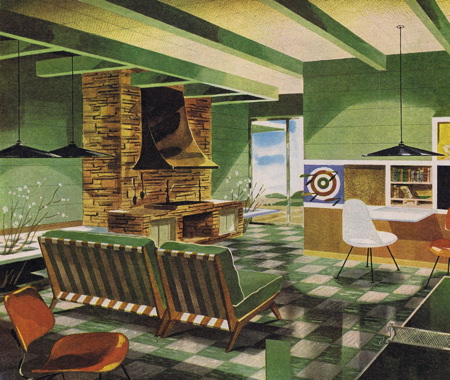
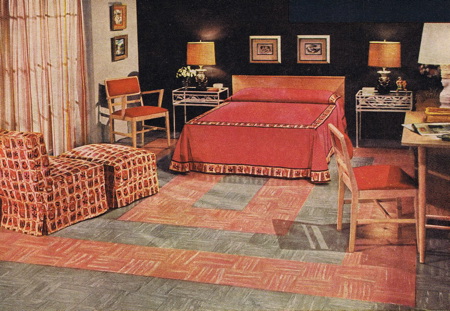
One of the selling features of this miracle floor covering was that you could glue it down yourself, in squares, as shown here in 1952. That was before the self-stick variety.


By the early 1960s, floor covering was being made of poly vinyl chloride (PVC), which was shinier and easier to care for. You can certainly see the difference by the time these ads appeared in 1968.




And by 1970 when the ads below ran, floor companies had ushered in my least favorite period of floor styles: the fake brick and fake wood look. And that horrible cork look.
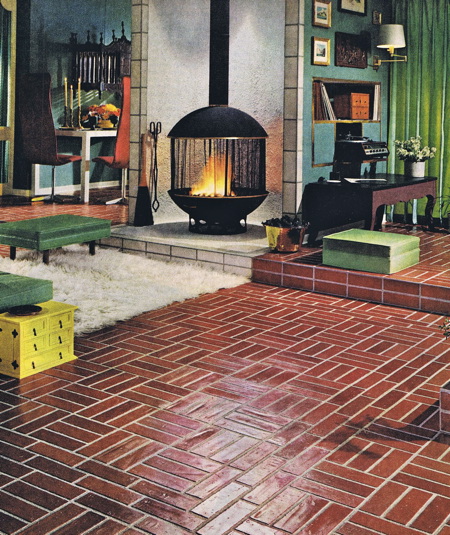

I took my first steps on linoleum. I can remember when the new “no-wax” plastic floors came into style. I’m sure they were a boon to the housewife, but they sure lost some style, compared to floors like these, all from 1953.

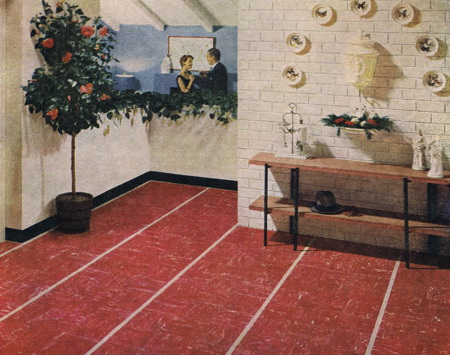
My friend in search of a retro floor covering ultimately decided on Marmoleum, which is an old-style material made to modern specs that snaps together. I think it will look pretty good, actually, though it’s just solid colors arranged in a pattern, such as these from 1952.


But really, if you could have you pick of kitchen floors, wouldn’t you choose this one from 1954? I certainly would.

This article was last modified on May 17, 2023
This article was first published on October 2, 2009




How can I recreate this Armstrong pattern, circa 1971? We’re about to remodel the kitchen (retro-style, of course! We’ve put it off but subfloor issues mandate immediate action) and I’m preserving a 2’X2′ piece of the original vinyl asbestos floor covering.
Thanks in advance for sharing helpful hints, sources, etc. I tend to discover the best way to accomplish a home project soon after my home project is completed; for once, I’d like to do it once and do it right!
Where can one buy retro linoleum?
really i ever had seen this type of home creativity in ma life seriously i wanna my house like this Kitchen & Bath Design that is gr88888888
I really appreciate the pics and the cooments.
I’m tearing apart a kitchen with a few 40s/50s details: metal sink cabinets and the lino floor I was so awed by as a youth.. It’s too far gone. Can I create a reasonable facsimile with marmoleum or somesuch?
FANTASTIC piece, made me nostalgic. Which brings me to my question, I discovered this article because I was desperately searching for information/ image of linoleum from the 60’s/70’s. A particular geometric pattern that holds memories of my Granny’s house is vivid in my mind, but short of asking my mum to cut me a piece and post it to me…I wondered if anyone knew of a supplier/stockist of vintage linoleum from those decades. Any info, site address would be appreciated. Thanks Emma. emilyjay2@yahoo.co.uk
There was linoleum tile. It was good stuff. Enameled rugs were common, decorative, and cheap. “Inlaid Linoleum” was the distiquishing terminolagy for the solid material. Asphalt tile was also common, and rubber tile was used after WW11. Vinyl-asbestos tile replaced most asphalt tile in the 1950’s-1960’s. Printed patterns, often embossed, and covered with transparent plastic could be produced cheaply and replaced most solid floor coverings in the 1970’s and on to today
sesli sohbet sesli chat
Aaah…floor memories. Reminds me of my grandparents basement (3rd picture from bottom of this page). What amazes me is that “back then” everything looked so fresh and clean. Now I run away from the word “linoleum”.
I remember a lot of those floors. The term “Linoleum” was used in its generic sense for a lot of those old ads. There was linoleum tile. It was good stuff. Enameled rugs were common, decorative, and cheap. “Inlaid Linoleum” was the distiquishing terminolagy for the solid material. Asphalt tile was also common, and rubber tile was used after WW11. Vinyl-asbestos tile replaced most asphalt tile in the 1950’s-1960’s. Printed patterns, often embossed, and covered with transparent plastic could be produced cheaply and replaced most solid floor coverings in the 1970’s and on to today. Similar to the old enameled rugs, but unlike the rugs, they were usually “inlaid”. More like wallpaper than floor covering.
Many of those pictures are of composition (vinyl/asbestos) tile, not of linoleum.
Kentile (the box visible in background in one ad) was compisition tile. Also, the painted stuff was more of a heavy tar paper and were called “felt rugs”, an inexpensive way to cover a bare wood floor. Even up to the mid 70’s you could buy them. There MAY have been linoleum tile, but I don’t ever remember any. Same with the painted stuff, I suppose someone could have sold painted pattern linoleum, but asphalt/felt rugs are all I have ever seen.
Dave, son of an old tyme linoleum layer
Wow, I miss Linoleum. It certainly capitalized on the fifth wall concept. Some of it was so charming. I think it should have been limited to the kitchen and bath though. Most of my friends had their rec room floors covered with the PVC stuff. Our house was built in 1926 and we still have Linoleum in the WC (its not in such good shape anymore).